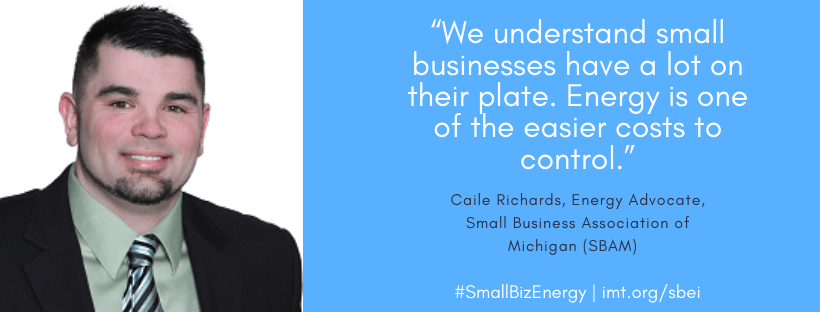The Small Business Energy Initiative (SBEI) is led by the Institute for Market Transformation (IMT) and the Greater Cleveland Partnership/Council of Smaller Enterprises (GCP/COSE). With support from the U.S. Department of Energy, the Initiative is partnering with local chambers of commerce and similar small business organizations from five regions across the country to arm them with leading-edge tools, best practices, and guidance to create energy efficiency and sustainability opportunities for their small business members that are good for the bottom line and good for the planet. In our SBEI Q&A series, we learn from the changemakers who are rolling up their sleeves every day to build an energy-efficient and prosperous future for their business members and local communities.

Caile Richards is the Energy Advocate for the Small Business Association of Michigan (SBAM). In his unique role, he leads collaborative efforts with Michigan’s electric utilities Consumers Energy and DTE Energy to provide enhanced energy services to small businesses. In this Q&A, Caile shares how SBAM is forming new strategic partnerships to grow its energy program’s reach and unlock more energy- and dollar-savings opportunities for small business owners across the state.
How does SBAM leverage its relationships with other local organizations to drive energy savings for small businesses?
SBAM has established relationships with about 30 strategic partners that are made up of other business organizations — usually other associations or local chambers of commerce all across Michigan. As SBAM is relatively unique in our efficiency work and I’m a full-time staff member dedicated to helping businesses save energy, I frequently get involved with these organizations’ events to increase awareness around the benefits of energy efficiency, highlight the available programs for businesses, and offer assistance in navigating the journey to better building performance.
How are your state’s utilities providing value to your energy solutions program?
SBAM’s members are varied in type and location, so the ability to offer all of our members — no matter who their utility is — the same programs with the same level of service and the same benefits is important to us. That makes working with Consumers Energy, DTE Energy, and other third-party implementers vital for success. In addition, the utilities are members of local chambers of commerce themselves and have close ties with other local business organizations and small businesses — this allows us to reach a broader audience even beyond our own membership.
Can you share an example of a local business taking advantage of energy efficiency and how they benefited from working with SBAM?
SBAM recently worked with Fenton Winery and Brewery in southeast Michigan to upgrade their dated lighting system. The facility was built in 2000 and, while the owners knew the old lighting was wasting a lot of energy, they didn’t have time to wade through the logistics of acquiring utility incentives. After only two meetings with SBAM and receiving a walkthrough to identify solutions, Fenton had 17 lightbulbs replaced with LEDs at no cost, and is now saving $1,800 per year on top of providing a better-lit indoor environment. Next up the business is looking at additional energy savings opportunities such as revamping their outdoor lighting and HVAC systems.

Why should other small business organizations launch an energy efficiency program? How has SBAM’s Energy Solutions program benefitted the organization?
SBAM’s Energy Solutions program has been great for all that have been involved. We have brought in new partners, increased advertising revenue, and acquired new members that would have never joined without this program. Furthermore, with energy efficiency we have expanded the expertise we offer our members into new areas and have given small businesses a seat at the table for state and local energy policy discussions.
Can you provide some examples of this success in action?
We’ve formed new partnerships with the Lansing Board of Water and Light, as well as energy solutions providers Slipstream and CLEAResult. To further grow our efforts, we’ve made connections with the Michigan Energy Office and are working with Michigan Saves on its Michigan Governors Energy Excellence Awards, as well as the three 2030 districts in the state — especially the Grand Rapids 2030 District which hosts the Michigan Battle of the Buildings.
Several contractors have now joined SBAM to become a part of our preferred contractor network and we are working on a new partnership with the Michigan Energy Efficiency Contractors Association (MEECA). A couple business owners who received energy audits and who were not already members have also joined.
To help boost SBAM’s advertising revenue, DTE purchased the back cover of our Focus Magazine for the entire year and the Lansing Board of Water and Light purchased a booth at our annual meeting. Furthermore, the Michigan Energy Office sponsored an energy panel discussion at our annual meeting and we’ve done advertising with Clear Result to reach members in its service territories. Knowing that they will have an audience, and we have shown success at reaching small businesses, they feel the money is well spent.
What are the challenges associated with helping small businesses become more energy efficient and how has joining the Small Business Energy Initiative helped move past barriers?
One of the biggest challenges has been spreading awareness about existing energy efficiency opportunities. Small business owners are busy. Getting their attention for something they do not typically have on the front of their minds is tough. The Small Business Energy Initiative has been invaluable in helping us develop strategies and ideas on how to reach more of our members. The resources that IMT has provided and the round-table discussions with other similar organizations have helped us to craft more targeted and effective energy efficiency offerings and reach more of our members.

